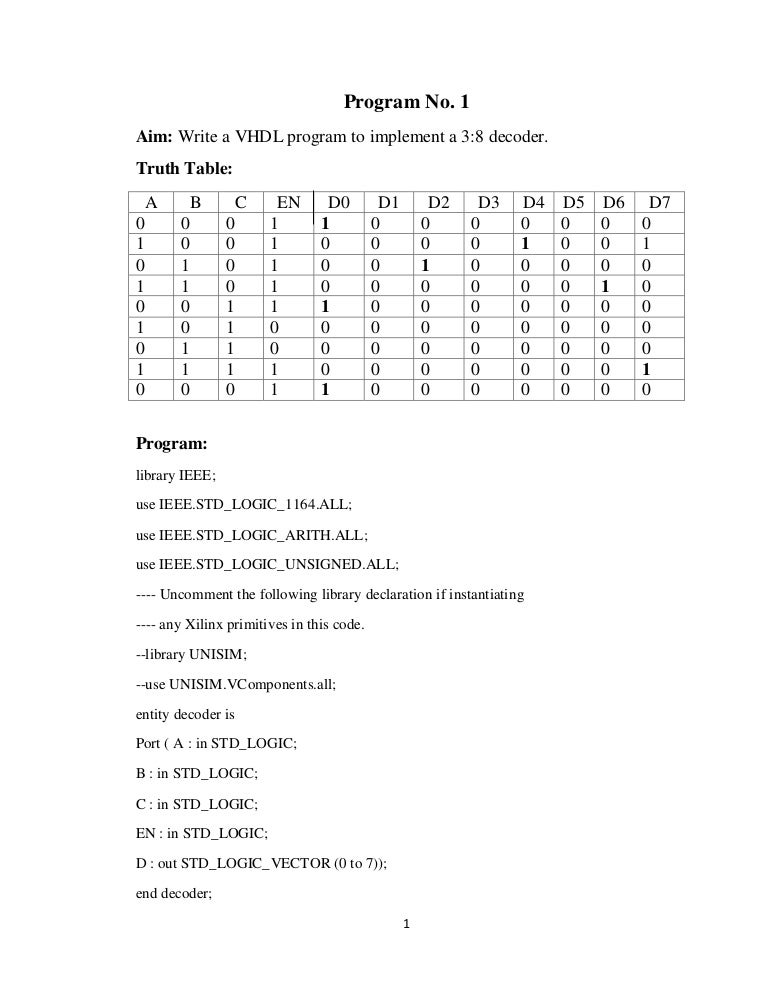Implement Program Counter Vhdl Code
Oct 20, 2014. PC OUT: the current program counter (output, 32 bits). • Clock (input, single line). • Reset (input, single line). These ports are visible to the outside world and are defined within the bock's entity. Code snippet 1.3 represents the port declarations. Algorithm 1.3: VHDL port declaration of the program counter. Jul 23, 2015. This is part of a series of posts detailing the steps and learning undertaken to design and implement a CPU in VHDL. There is quite a bit of work to this in terms of the various ways of connecting up a RAM to the CPU and having a unit to manage the program counter and the fetching of the next one. Both simulation and real implementation run without any problem. 1.3 Design in VHDL 1.3.1 Program Counter One of the rst blocks to be designed is the program counter (PC). According to previous. Before writing any single line of VHDL code, one should list the necessary behavior: 8.
The following code implements a two digit counter and displays the output on seven segments. As can be seen, in each clock cycle, the value has to be changed but the simulation results doesn't show such thing. To reduce the code size, I only put 0 and 1 in the seven segment driver.
Implement Program Counter Vhdl Codes
3 Answers
Unfortunately your d2 counter doesn't work properly besides the missing assignments to y:
d2 the bottom trace should hold each value for 10 counts of d1 (here shown as ten seconds. The if statements aren't comprehensive and should be changed. d1 is showing up incorrectly as well.
Fix that by nesting the two counter if statements:
And that produces:
Your question's other answers could have pointed this out if your question had provided a Minimal, Complete and Verifiable example.
Did you really mean for case d2 to overwrite the value assigned to x by the case d1 statement? Or did you mean y?
If the logic that derives x and y from d1 and d2 is purely combinatorial, you can move it out of the process.
Not the answer you're looking for? Browse other questions tagged vhdl or ask your own question.
 $begingroup$
$begingroup$A program counter is a register that contains the address of the instruction being executed at the current time. Data, instruction and address are stored in ROM memory.

How does program counter operate?
I am reading this page enter link description here
I have few basic questions plan : program counter design I have to make loadable program counter whenever we design circuit we should know some basicwhat should I know ?which component I need to design basic PC ?I know we add some mux but I don't understand how to start ?

1 Answer
$begingroup$The program counter (PC) is a binary counter that contains the address of the next instruction to be executed. For this reason it is sometimes referred to as the instruction address register. The PC is generally incremented just after the current instruction has been fetched.
Assuming a byte-addressable memory, on a RISC machine, where all the instructions are the same length (e.g. 32-bits on the MIPS-based PIC32), then the PC will be incremented by the instruction length (in this case four) after each instruction. On a CISC processor, like the Intel x86 series, where the instructions can be variable length, then the PC will be incremented by the size of the current instruction.
Some program memories are word-addressable only, and instructions may only be one or two words longs, in which case the PC would be incremented by 1 or 2 respectively.
Programs execute linearly, unless a jump instruction is executed. An unconditional jump always modifies the PC; a conditional jump modifies the PC only if the condition stated in the conditional instruction (such as, reg n is 0).
A jump instruction may either contain the address of the next instruction to be executed, in which case the PC is overwritten with the address in the instruction, or it may contain a signed relative value, which is added to the current PC value to obtain the next address. Sometimes the latter are referred to as branch instructions. They may be either unconditional or conditional.
For the PIC32 MIPS architecture, jump instructions save two bits in the address field of the instruction by only specifying the target address divided by four, since all instructions are known to be on a four-byte boundary. In fact, if an attempt was made to jump to an address that was not on a four-byte boundary, a hardware exception would be raised.
A call or jump to subroutine instruction also modifies the PC (usually the address of the subroutine is contained in the call instruction, although some processors implement a relative branch to subroutine instruction as well). The main difference between a jump instruction and a subroutine call is the the PC is usually saved on a stack, and at the end of the subroutine, a return instruction is executed that retrieves this value and places it in the the PC, so the program resumes executing immediately after the original subroutine call instruction.
Often on smaller microcontrollers, only a 16-bit program address space will be implemented, limiting the program to 65536 bytes. If it is desired to go beyond this limit, then a paging scheme may be used, with (for example) a 16K 'window' reserved in the 64K address space, extended to 128K bytes by providing eight 16K pages. A special 'paging register' is used to select which page is active.